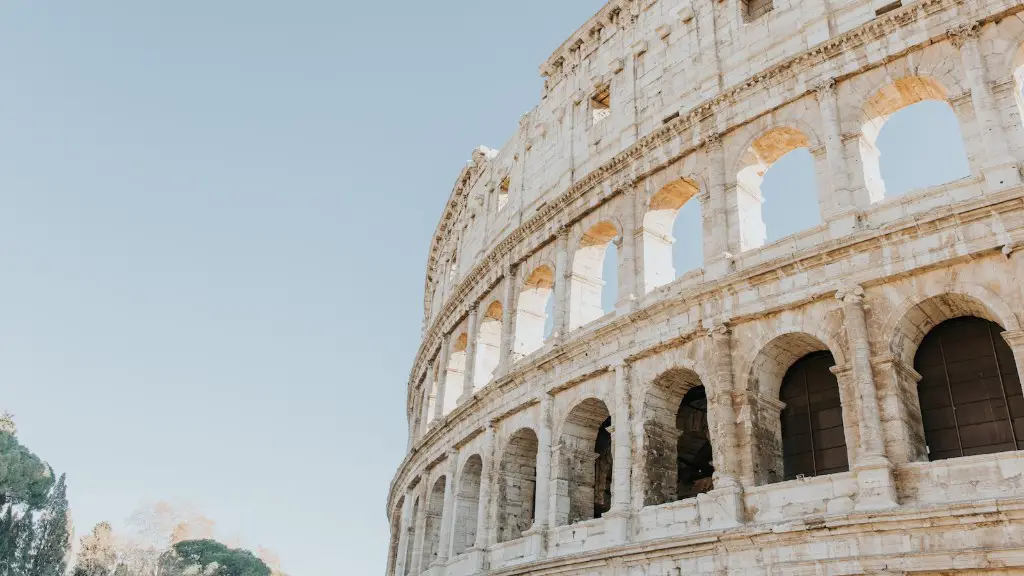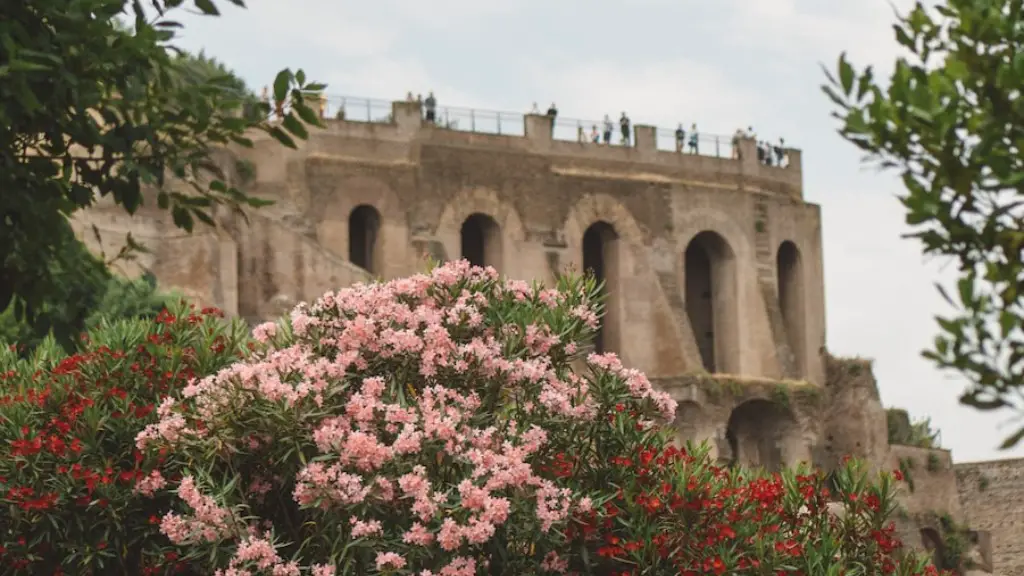Why Did Ancient Romans Build Aqueducts
The ancient Roman Empire is renowned for its ingenious engineering feats in the form of aqueducts. Aqueducts were crucial for the Romans to accomplish the necessary tasks for their daily life such as supplying fresh water for drinking, bathing, and cleaning. The Romans had a great need for water, which is why they created this very ingenious way of providing their cities with water. Aqueducts were a necessity in the Roman Empire, as they enabled civilization to thrive.
Before the advancements of Roman engineering, water was collected in cisterns. Cave systems, underground reservoirs, and natural springs all contained water, but due to their state, their water was often dirty and unhealthy to drink. The Romans were aware of the need for clean and healthy water for drinking, and thus embarked on the construction of aqueducts.
Aqueducts were long channels that utilised gravity to move water from source to destination. These channels contained a constant flow of water which was fed from various bodies such as rivers, lakes and natural springs. That water was then brought across long distances, sometimes up to several hundred miles. To prevent water from escaping, or flowing away, the Romans created a clever system consisting of brick-built chutes, lead pipes, and siphons. This helped to keep water loss to a minimum as it was travelling across the aqueduct and thus enabled a constant flow.
Aqueducts also contained water filtered through a series of tunnels, chutes and deflectors. This process allowed the Romans to create clean water, which was instrumental in the health of the citizens. Through their engineering, the Roman Empire produced one of the most advanced and successful water supply networks in ancient times. The Roman aqueducts were not just a means to an end, but they also became symbols of the Roman Empire’s wealth and power.
The Roman aqueducts helped to improve the quality of life in the Roman Empire, as they provided the citizens with a steady and reliable supply of clean water. In modern times, aqueducts are still used for many of the same purposes as in ancient times. The Roman Empire serves as a testament to the ingenuity of human engineering, as the aqueducts were able to provide their civilization with much-needed water for many centuries to come.
Strong Bond Between Machines and Structures
Rome was the first to build aqueducts to provide water to their cities. This allowed them to collect and manage a much larger quantity of water than ever before. Aqueducts also enabled a sense of unity between cities, as they were connected to each other by a network of water sources and channels. This aspect of unity was an integral part of the Roman Empire, as it allowed them to maintain strong ties and a feeling of solidarity between cities.
The aqueducts of ancient Rome were built with great precision, as they had to carry a large amount of water over long distances. The aqueducts had to be structurally sound and were constructed out of stone and concrete. The aqueducts were marked with an inscription or a reference to the emperor, which is a testament to the Roman’s engineering prowess and skill. To ensure that water reached where it was needed, the Romans developed an intricate system of water channels, valves and other hydraulic machines.
To ensure that water reached the destination, engineers had to be knowledgeable in astrology and mathematics, as the water had to travel a certain angle over the terrain and had to be in line with the gravitational force. The Romans were adept at calculating the terrain and adjusting their aqueducts accordingly to maintain a steady flow of water.
The aqueducts also enabled a sense of communication between cities, as water was transported from one place to another. This enabled trade and communication between cities, which was pivotal in the success of the Roman Empire. Water was also a major factor in warfare, as it enabled Roman soldiers to have an adequate supply of water in the battlefield.
Aqueducts Influenced Roman Architecture
The aqueducts of the Roman Empire had a profound effect on the architecture of the time period. Aqueducts had to be built to be strong and resilient, as they had to survive centuries of changing weather and terrain. The aqueducts were built to be structurally sound and were made with a very uniform architecture. This aspect of uniformity had a major influence on the architecture of the Roman Empire, as it helped to establish a sense of order and class within the architecture of the time.
The aqueducts were very carefully planned and had a great architectural importance. The structure of the aqueducts completely changed the landscape, as they were designed to connect cities and span great distances. This enabled cities to communicate with each other, as they could send water over great distances.
The aqueducts were also a great source of pride for the Roman Empire, as they demonstrated the engineering proficiency of their citizens. Aqueducts were seen as a symbol of the Roman Empire’s prosperity and power, as they enabled the Roman Empire to keep in line with their ambitious projects. Aqueducts were also a source of inspiration for the Roman Empire, as they helped to inspire future generations of engineers.
Romans Used Aqueducts For Different Purposes
As mentioned previously, the aqueducts allowed the Roman Empire to provide the cities with clean and healthy drinking water. This was an essential part of everyday life, as it enabled citizens to have access to a clean water source. Other than supplying drinking water, the aqueducts were used for other purposes such as irrigation, bathing, and hygiene.
The Romans also used the aqueducts to transport goods and supplies across vast distances. This enabled the Romans to keep cities connected to each other, as well as increased trade in the Roman Empire. By using vessels, the Romans were able to transport goods and supplies from one city to another with ease.
One of the most unique uses for the Roman aqueducts was for entertainment purposes. The aqueducts served as a source of power for ancient Roman games and events. For example, the Romans would utilise the aqueducts to power water-driven machines in their amphitheatres. These machines powered water-related events such as fountain shows, water battles and water-related plays. People would gather to watch these events, and it served as a major source of entertainment in the ancient world.
Roman Aqueducts Last Beyond The Empire
The legacy of the Roman Empire is still evident today, as many of its aqueducts are still in use. This is a testament to the Roman Empire’s engineering prowess, as they were able to create a system that could endure the test of time. Many of the aqueducts are still in use today and are being used for the same purposes as in Roman times. This shows the brilliance of the Roman Empire’s engineering, as their aqueducts were able to stand the test of time.
The Romans were able to create an efficient system of engineering that enabled them to accomplish their goals. This was instrumental in the success and growth of their civilization, as the aqueducts were able to provide their cities with much-needed water. Aqueducts were a crucial aspect of the Roman Empire, as they enabled the empire to thrive for centuries to come. The Romans were able to create a system of engineering that was advanced and allowed them to accomplish great feats, making them a civilization to be remembered.
Aqueducts Remain Relevant In Modern Times
In modern times, aqueducts remain a relevant form of engineering. Many cities still use aqueducts to provide water to their citizens. Aqueducts are still being built and new ones are being designed to withstand newer technologies. Aqueducts are also being used to transport waste water, making them efficient and reliable. Modern cities are able to reap the same benefits that the ancient Roman cities were able to, as aqueducts are still a reliable way of providing water.
Aqueduct engineering has seen advances over the years and is now able to withstand the test of time better than before. Modern aqueducts are built from more durable materials and can be built to span larger distances. The modern aqueduct systems offer many benefits, such as efficiency and reliability, and can provide cities with an adequate supply of clean water.
Aqueducts are an essential part of any city and are still being used today in many ways to ensure an adequate supply of clean water. Aqueducts provide cities with vital resources and can help to sustain life, as they can provide a safe and reliable supply of clean water. The engineering feat of the aqueducts remains relevant today, as they are still used to provide cities with a safe and reliable source of water.





